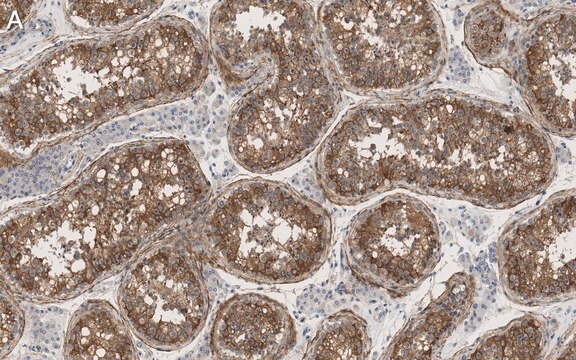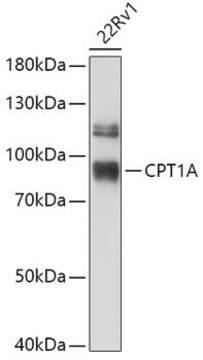17-10125
ChIPAb+ Dimethyl-Histone H3 (Lys79) - ChIP Validated Antibody and Primer Set, rabbit monoclonal
culture supernatant, clone NL59, from rabbit
Se connecterpour consulter vos tarifs contractuels et ceux de votre entreprise/organisme
About This Item
Code UNSPSC :
12352203
eCl@ss :
32160702
Nomenclature NACRES :
NA.52
Produits recommandés
Source biologique
rabbit
Niveau de qualité
Forme d'anticorps
culture supernatant
Clone
NL59, monoclonal
Espèces réactives
human, vertebrates
Fabricant/nom de marque
ChIPAb+
Upstate®
Technique(s)
ChIP: suitable
western blot: suitable
Isotype
IgG
Numéro d'accès NCBI
Numéro d'accès UniProt
Conditions d'expédition
dry ice
Informations sur le gène
human ... H3F3B(3021)
Description générale
All ChIPAb+ antibodies are individually validated for chromatin precipitation, every lot, every time. Each ChIPAb+ antibody set includes control primers (tested every lot by qPCR) to biologically validate your IP results in a locus-specific context. The qPCR protocol and primer sequences are provided, allowing researchers to validate ChIP protocols when using our antibody in their chromatin context. Each set also includes a negative control antibody to ensure specificity of the ChIP reaction.
The ChIPAb+ Dimethyl-Histone H3 (Lys79) set includes the Dimethyl-Histone H3 (Lys79) antibody, a negative control rabbit supernatant, and qPCR primers which amplify a 166 bp region of human GAPDH. The Dimethyl-Histone H3 (Lys79) and negative controls are supplied in a scalable "per ChIP" reaction size and can be used to functionally validate the precipitation of Dimethyl-Histone H3 (Lys79)-associated chromatin.
The ChIPAb+ Dimethyl-Histone H3 (Lys79) set includes the Dimethyl-Histone H3 (Lys79) antibody, a negative control rabbit supernatant, and qPCR primers which amplify a 166 bp region of human GAPDH. The Dimethyl-Histone H3 (Lys79) and negative controls are supplied in a scalable "per ChIP" reaction size and can be used to functionally validate the precipitation of Dimethyl-Histone H3 (Lys79)-associated chromatin.
Histone H3 is one of the five main histone proteins involved in the structure of chromatin in eukaryotic cells. Featuring a main globular domain and a long N-terminal tail, H3 is involved with the structure of the nucleosomes of the ′beads on a string′ structure.
The N-terminal tail of histone H3 protrudes from the globular nucleosome core and can undergo several different types of epigenetic modifications that influence cellular processes. These modifications include the covalent attachment of methyl or acetyl groups to lysine and arginine amino acids and the phosphorylation of serine or threonine.
The N-terminal tail of histone H3 protrudes from the globular nucleosome core and can undergo several different types of epigenetic modifications that influence cellular processes. These modifications include the covalent attachment of methyl or acetyl groups to lysine and arginine amino acids and the phosphorylation of serine or threonine.
Spécificité
Broad species cross-reactivity expected due to sequence homology
Recognizes dimethyl-histone H3 (Lys79).
Immunogène
Epitope: Dimethyl Lys79
KLH-conjugated synthetic peptide containing the sequence DFme2KTD corresponding to dimethyl-lysine at position 79 of histone H3. The immunizing sequence is identical in human, mouse, rat and yeast. A C-terminal cysteine was added to facilitate conjugation.
Application
Chromatin Immunoprecipitation:
Representative lot data.
Sonicated chromatin prepared from HeLa cells (1 X 10E6 cell equivalents per IP) were subjected to chromatin immunoprecipitation using either 4 µL of Negative Control Supernatant , or 4 µL of Anti-dimethyl-Histone H3 (Lys79) and the Magna ChIP® A Kit (Cat. # 17-610).
Successful immunoprecipitation of dimethyl-Histone H3 (Lys79) associated DNA fragments was verified by qPCR using Control Primers as a positive locus, and human β-globin as a negative locus (Figure 2). Data is presented as percent input of each IP sample relative to input chromatin for each amplicon and ChIP sample as indicated.
Please refer to the EZ-Magna ChIP A (Cat. # 17-408) or EZ-ChIP (Cat. # 17-371) protocol for experimental details.
Western Blot Analysis:
Representative lot data.
HeLa cell nuclear extracts were resolved by electrophoresis, transferred to nitrocellulose and probed with anti-dimethyl-Histone H3 (Lys79) (1:4,000 dilution). Proteins were visualized using a goat anti-rabbit secondary antibody conjugated to HRP and a chemiluminescence detection system.
Arrow indicates dimethylhistone H3 (~17 kDa) (Figure 3).
Dot Blot Analysis:
Absurance Histone H3 Antibody Specificity Array (Cat. No. 16-667) and Absurance Histone H2A, H2B, H4 Antibody Specificity Array (Cat. No. 16-665), which contain histone peptides with various modifications were probed with dimethyl-Histone H3 (Lys79) Antibody, clone NL59 at 1:500 dilution. Proteins were visualized using a Donkey anti-rabbit IgG conjugated to HRP and a chemiluminescence detection system.
Dot Blot: Representative lot data.
Specificity of a representative lot confirmed by the ability of a 1:2500 dilution of the antibody to recognize peptides corresponding to regions of histone H3 with various modifications (Figure 4).
Multiplex Assay: Representative lot data.
Representative lot data.
Sonicated chromatin prepared from HeLa cells (1 X 10E6 cell equivalents per IP) were subjected to chromatin immunoprecipitation using either 4 µL of Negative Control Supernatant , or 4 µL of Anti-dimethyl-Histone H3 (Lys79) and the Magna ChIP® A Kit (Cat. # 17-610).
Successful immunoprecipitation of dimethyl-Histone H3 (Lys79) associated DNA fragments was verified by qPCR using Control Primers as a positive locus, and human β-globin as a negative locus (Figure 2). Data is presented as percent input of each IP sample relative to input chromatin for each amplicon and ChIP sample as indicated.
Please refer to the EZ-Magna ChIP A (Cat. # 17-408) or EZ-ChIP (Cat. # 17-371) protocol for experimental details.
Western Blot Analysis:
Representative lot data.
HeLa cell nuclear extracts were resolved by electrophoresis, transferred to nitrocellulose and probed with anti-dimethyl-Histone H3 (Lys79) (1:4,000 dilution). Proteins were visualized using a goat anti-rabbit secondary antibody conjugated to HRP and a chemiluminescence detection system.
Arrow indicates dimethylhistone H3 (~17 kDa) (Figure 3).
Dot Blot Analysis:
Absurance Histone H3 Antibody Specificity Array (Cat. No. 16-667) and Absurance Histone H2A, H2B, H4 Antibody Specificity Array (Cat. No. 16-665), which contain histone peptides with various modifications were probed with dimethyl-Histone H3 (Lys79) Antibody, clone NL59 at 1:500 dilution. Proteins were visualized using a Donkey anti-rabbit IgG conjugated to HRP and a chemiluminescence detection system.
Dot Blot: Representative lot data.
Specificity of a representative lot confirmed by the ability of a 1:2500 dilution of the antibody to recognize peptides corresponding to regions of histone H3 with various modifications (Figure 4).
Multiplex Assay: Representative lot data.
Research Category
Epigenetics & Nuclear Function
Epigenetics & Nuclear Function
Research Sub Category
Histones
Histones
This ChIPAb+ Dimethyl-Histone H3 (Lys79) -ChIP Validated Antibody & Primer Set conveniently includes the antibody & the specific control PCR primers.
Conditionnement
25 assays per set. Recommended use: ~4 μL of antibody per chromatin immunoprecipitation (dependent upon biological context).
Qualité
Chromatin Immunoprecipitation:
Sonicated chromatin prepared from HeLa cells (1 X 10E6 cell equivalents per IP) were subjected to chromatin immunoprecipitation using either 4 µL of Negative Control Supernatant , or 4 µL of Anti-dimethyl-Histone H3 (Lys79) and the Magna ChIP® A Kit (Cat. # 17-610). Successful immunoprecipitation of dimethyl-Histone H3 (Lys79) associated DNA fragments was verified by qPCR using Control Primers (Figure 1).
Please refer to the EZ-Magna ChIP A (Cat. # 17-408) or EZ-ChIP (Cat. # 17-371) protocol for experimental details.
Sonicated chromatin prepared from HeLa cells (1 X 10E6 cell equivalents per IP) were subjected to chromatin immunoprecipitation using either 4 µL of Negative Control Supernatant , or 4 µL of Anti-dimethyl-Histone H3 (Lys79) and the Magna ChIP® A Kit (Cat. # 17-610). Successful immunoprecipitation of dimethyl-Histone H3 (Lys79) associated DNA fragments was verified by qPCR using Control Primers (Figure 1).
Please refer to the EZ-Magna ChIP A (Cat. # 17-408) or EZ-ChIP (Cat. # 17-371) protocol for experimental details.
Description de la cible
17 kDa
Forme physique
Anti-Dimethyl-Histone H3 (Lys79) (rabbit Monoclonal), Part No. CS204341. One vial containing 100 µL of cultured supernantant in 0.05% sodium azide. Store at -20°C.
Negative Control Supernatant, Part No. CS200567. One vial containing 100 µL of cultured supernatant in 0.05% sodium azide. Store at -20°C.
Control Primers, Part No. 22-004. One vial containing 75 μL of 5 μM of each primer specific for human GAPDH. Store at -20°C.
FOR: TAC TAG CGG TTT TAC GGG CG REV: TCG AAC AGG AGG AGC AGA GAG CGA
Negative Control Supernatant, Part No. CS200567. One vial containing 100 µL of cultured supernatant in 0.05% sodium azide. Store at -20°C.
Control Primers, Part No. 22-004. One vial containing 75 μL of 5 μM of each primer specific for human GAPDH. Store at -20°C.
FOR: TAC TAG CGG TTT TAC GGG CG REV: TCG AAC AGG AGG AGC AGA GAG CGA
Stockage et stabilité
Stable for 1 year at -20°C from date of receipt. Handling Recommendations: Upon first thaw, and prior to removing the cap, centrifuge the vial and gently mix the solution. Aliquot into microcentrifuge tubes and store at -20°C. Avoid repeated freeze/thaw cycles, which may damage IgG and affect product performance.
Remarque sur l'analyse
Control
Includes negative control rabbit supernatant and primers specific for human GAPDH.
Includes negative control rabbit supernatant and primers specific for human GAPDH.
Informations légales
MAGNA CHIP is a registered trademark of Merck KGaA, Darmstadt, Germany
UPSTATE is a registered trademark of Merck KGaA, Darmstadt, Germany
Clause de non-responsabilité
Unless otherwise stated in our catalog or other company documentation accompanying the product(s), our products are intended for research use only and are not to be used for any other purpose, which includes but is not limited to, unauthorized commercial uses, in vitro diagnostic uses, ex vivo or in vivo therapeutic uses or any type of consumption or application to humans or animals.
Code de la classe de stockage
10 - Combustible liquids
Certificats d'analyse (COA)
Recherchez un Certificats d'analyse (COA) en saisissant le numéro de lot du produit. Les numéros de lot figurent sur l'étiquette du produit après les mots "Lot" ou "Batch".
Déjà en possession de ce produit ?
Retrouvez la documentation relative aux produits que vous avez récemment achetés dans la Bibliothèque de documents.
Notre équipe de scientifiques dispose d'une expérience dans tous les secteurs de la recherche, notamment en sciences de la vie, science des matériaux, synthèse chimique, chromatographie, analyse et dans de nombreux autres domaines..
Contacter notre Service technique







